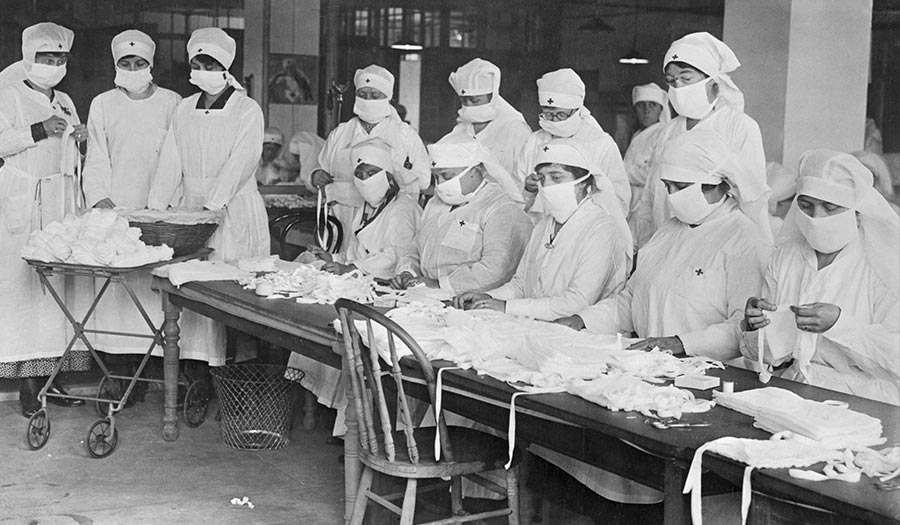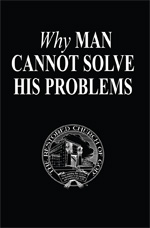 Getty Images
Getty Images
Article
Learn the why behind the headlines.
Subscribe to the Real Truth for FREE news and analysis.
Subscribe NowDespite a century’s progress in science, 2020 is looking a lot like 1918.
In the years between two lethal pandemics, one the misnamed Spanish flu, the other COVID-19, the world learned about viruses, cured various diseases, made effective vaccines, developed instant communications and created elaborate public-health networks.
Yet here we are again, face-masked to the max. And still unable to crush an insidious yet avoidable infectious disease before hundreds of thousands die from it.
As in 1918, people are again hearing hollow assurances at odds with the reality of hospitals and morgues filling up and bank accounts draining. The ancient common sense of quarantining is back. So is quackery: Rub raw onions on your chest, they said in 1918. What about drinking methanol now? Over 700 people have died in Iran from drinking the toxic alcohol thinking it would protect them from the virus.
In 1918, no one had a vaccine, treatment or cure for the great flu pandemic as it ravaged the world and killed more than 50 million people. No one has any of that for the coronavirus, either.
It has been over a century since the influenza pandemic—a period that included 10 decades of incredible scientific advancements—and events are playing out in an eerily similar way. Laying out these parallels reveals a powerful lesson about mankind.
Past Meets Present
Modern science quickly identified today’s new coronavirus, mapped its genetic code and developed a diagnostic test, tapping knowledge no one had in 1918. That has given people more of a fighting chance to stay out of harm’s way, at least in countries that deployed tests quickly.
But the ways to avoid getting sick and what to do when sick are little changed. Government leaders hesitant to take radical action also joins past to present.
Not once, historians say, did President Woodrow Wilson publicly speak about the influenza that was killing Americans grotesquely and in huge numbers, even though he contracted it himself and was never the same after. Wilson fixated on America’s parallel fight in World War I like “a dog with a bone,” says John M. Barry, author of “The Great Influenza.”
The suspected ground zero of the Spanish flu ranges from Kansas to China. But it was clear to U.S. officials even in 1918 that it did not start in Spain.
The pandemic took on Spain’s name only because its free press ambitiously reported the devastation in the disease’s early 1918 wave while government officials and a complicit press in countries at war—the U.S. among them—played it down in a time of staunch patriotism, censorship and denial.
Like COVID-19, the 1918 pandemic came from a respiratory virus that jumped from animals to people, was transmitted the same way, and had similar pathology, Mr. Barry said by email. Social distancing, hand-washing and masks were leading control measures then and now.
Medical advice from then also resonates today: “If you get it, stay at home, rest in bed, keep warm, drink hot drinks and stay quiet until the symptoms are past,” said Dr. John Dill Robertson, Chicago health commissioner in 1918. “Then continue to be careful, for the greatest danger is from pneumonia or some kindred disease after the influenza is gone.”
In the manner of the day, there just had to be a catchy rhyme in circulation, too: “Cover up each cough and sneeze. If you don’t you’ll spread disease.”
But there were also marked differences between the viruses of 1918 and 2020. The Spanish flu was particularly dangerous to healthy people aged 20 to 40—the prime generation of military service—paradoxically because of their vibrant immune systems.
When such people got infected, their antibodies went after the virus like soldiers spilling from the trenches of Europe’s killing fields.
“The immune system was throwing every weapon it had at the virus,” Mr. Barry said. “The battlefield was the lung. The lung was being destroyed in that battle.”
Young soldiers and sailors massed at military camps in the U.S., sailed for Europe on ships stuffed to the gunwales with humanity, fought side by side in the trenches and came home in victory to adoring crowds. The toll was enormous, on them and the people they infected. The Spanish flu could just as easily have been called the U.S. Army or U.S. Navy flu instead. Or the German or British flu, for that matter.
Among those who died in the pandemic was Friedrich Trump, Donald Trump’s paternal grandfather. Among those who contracted it and recovered were the wartime leaders of Britain and Germany as well as of the United States, British and Spanish kings and the future U.S. president, Franklin Roosevelt, when he was assistant Navy secretary.
But the toll was heavier on average people and the poor, crowded in tenements, street cars and sweaty factories.
They could not all live by the words of the 1918 U.S. surgeon general, Rupert Blue: “Keep out of crowds and stuffy places as much as possible…The value of fresh air through open windows cannot be overemphasized…Make every possible effort to breath as much pure air as possible.”
The same is true today. Poor regions are set to be hit hardest by the coronavirus where social distancing is next to impossible. Vox wrote that secondary impacts of COVID-19 could include a “hunger pandemic” and “poverty tsunami.”
“The number of deaths they cause, experts caution, could easily outstrip the number of deaths from Covid-19 itself.”
In Mexico alone, the UN estimates the pandemic could push 34 million in Mexico into extreme poverty.
An estimated 675,000 Americans died in the 1918 pandemic, which is thought to have infected one-third of the global population. Tracking by Johns Hopkins University shows the continuing COVID-19 pandemic has killed more than 250,000 people globally, more than 68,000 in the United States.
Bad Science
In 1918, the surgeon general noted in a handbill that “a person who has only a mild attack of the disease himself may give a very severe attack to others.” The warning is just as applicable to the coronavirus, especially as scientists learned large numbers of people with COVID-19 may spread it despite no obvious symptoms. Exactly how often the new virus kills cannot be determined without better counts of the infected; some estimates put the 1918 flu’s death rate at 2.5 percent.
Blue’s public notice also warned people to avoid charlatans and only get medicine from doctors.
Physicians, though, did not always know what they were doing. Medical journals at the time describe a rash of unusual treatments.
One 1918-era doctor recommended that people sniff a boric acid and sodium bicarbonate (baking soda) powder to rinse out nasal passages. Others prescribed quinine, strychnine and a poisonous garden plant called Digitalis to help circulation, as well as drugs derived from iodine for “internal disinfection,” according to Laura Spinney, who wrote the 2017 book “Pale Rider: The Spanish Flu of 1918 and How it Changed the World.”
Popular theories spread that warming your feet would prevent infection, or gobbling brown sugar, or getting the onion rubdown. A “clean heart” was one supposed preventive, though it is not clear whether that meant the organ or the heart of love.
“There was no Tony Fauci back then,” Barry said in a remote Library of Congress interview in April.
We have Dr. Fauci now—a federal immunologist who has been regarded as the truth-teller in White House briefings. Plus, we know so much more than people did in 1918.
Yet we are still hearing lots of Dark Ages nonsense.
Conspiracy theorists have blamed COVID-19 on the development of 5G networks, just as they say radio waves caused the 1918 flu. Arsonists recently torched more than a dozen British cell towers after that falsehood circulated.
Over the months of this pandemic, The Associated Press has debunked a series of bogus remedies that spread on Facebook, Twitter and the like. No, blasting hot air up your nose from a hair dryer will not protect you. Nor will drinking tonic water, eating high-alkaline foods, stuffing antibiotic ointment up your nose, downing vodka or any home elixir.
No, it is not true that if you cannot hold your breath very long, you have COVID-19. Or that a vaccine from a lab only works on a disease created by a lab.
Social distancing has not come with social-media distancing. Over a century of science, we have not gone back to the future, but ahead to the past.
Lessons of 1918 (and 1919)
In September 1918, as the Spanish flu’s second and by far deadliest wave hit in the U.S., Philadelphia’s public health chief disregarded advisers and let a massive war-bond parade proceed through downtown. The H1N1 virus raced through the masses in what has been called the world’s deadliest parade. As officials insisted there was nothing to be alarmed about, people were seeing neighbors sicken and die with astonishing speed and mass graves being dug.
“It’s just the flu” had worn thin as the mantra of officialdom.
This example of the “world’s deadliest parade” and others like it could hold lessons for those alive today who are caught between stopping a virus and trying to keep economies alive.
Yet there is another lesson from the parallels between 1918 and 2020. It is a lesson of paradoxes that blindsides us every time there is a globe-changing crisis.
After the 9/11 attacks, columnist Peggy Noonan summarized in The Wall Street Journal the complex, jumbled track record of humanity. She began to put a finger on the paradox of mankind.
“In the long ribbon of history, life has been one long stained and tangled mess, full of famine, horror, war and disease. We must have thought we had it better because man had improved. But man doesn’t really ‘improve,’ does he? Man is man. Human nature is human nature; the impulse to destroy coexists with the desire to build and create and make better.”
Ms. Noonan then pointed out that this paradox was present back in 1900: “In the early 20th century the future was so bright they had to invent shades. They had everything—peace, prosperity, medical and scientific breakthroughs, political progress, fashion, glamour, harmless tasty scandals. The Gilded Age. And then all of a sudden they were hit by the most terrible war in all of European history, the most terrible plague in all of modern history (the Spanish flu) and on top of it all the most terrible political revolution in the history of man. And that was just the first 18 years.”
Here we are in 2020 and the future should look bright. Yet our forever problems of war, famine, disease and poverty continue to plague us like never before.
Why?
This is the question that must be answered if we are ever to have true peace and prosperity across the entire globe. Read Why Man Cannot Solve His Problems—by Real Truth Editor-in-Chief David C. Pack—to learn the answer.
This article contains information from The Associated Press.



